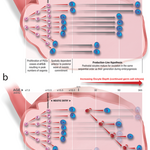Genetics & Molecular Biology

Mathematicians have proposed a new solution to understanding a MicroRNA puzzle; different and sometimes conflicting theories about ways in which microRNAs regulate protein production, since the results varied depending on only slightly changed experimental conditions.
The problem to date has been that scientists have differed over interpretations of how the production of the major building blocks of a cell, proteins, is controlled by microRNAs.Professor Alexander Gorban, who holds a Chair in Applied Mathematics at University of Leicester, said, “The old metaphor of an elephant and blind…

Is there a 'biological clock' that women recognize innately, and act on accordingly? New research casts some doubt on that.
The notion of a biological clock in women arises from the fact that immature egg cells- 'oocytes' - progressively decline in number as females get older, along with a decades-old view that oocytes cannot be renewed in mammals after birth. A recent genetic study tracing the origins of oocytes from the embryonic period throughout adulthood and adds new information to a growing controversy. Scientists from Massachusetts General Hospital and the University of Edinburgh…

Silicone and living cardiac muscle cells have been combined to form a freely swimming "jellyfish", proof of concept for reverse engineering a variety of muscular organs and simple life forms.
It also suggests a broader definition of what counts as synthetic life.
Study co-author Kevin Kit Parker previously demonstrated bioengineered constructs that can grip, pump, and even walk. He says the inspiration to mimic a jellyfish came out of frustration with the state of the cardiac field. Similar to the way a human heart moves blood throughout the body, jellyfish propel themselves through the…

Why Throw-Away Statements Harm the Anti-GMO Movement
As an academic research scientist active at the public interface, I enjoy communicating about complex science topics. With regard to trasngenic (GMO) crops, if you read my blogs, comments left online, or listen to audiences in public discussions, you'll see that they ultimately reach a common point.
Someone always indicates that Monsanto is my employer. Like clockwork.
I'm still waiting for the check. Actually, I never worked for them, consulted for them, or received a dime from them. As a university scientist my funding is all public…

We are currently witnessing the USDA public commentary period on the Arctic Apple, a transgenic apple that does not exhibit browning upon injury or cutting. The anti-browning trait was installed by scientists at Okanagan Specialty Fruits. A copy of the apple gene for polyphenol oxidase (PPO) was overexpressed, which triggers a plant response to silence the over-expressed gene. The same process also suppresses the apple’s endogenous PPO genes. Without this protein, the apple flesh cannot brown.
Trees have been growing for ten years and are poised for…

If you want to scare somebody, convince them that there is a remote chance of danger in their food, water or medicine. Even if there is no evidence to back up the claim, people respond strongly to such information, causing them to abandon safe foods for alternatives. Today this fear factor is being played to influence food policy and politics, as activists realize they can change consumption with distortions of truth and perpetuation of food phobias and food anxiety. Because it works like a charm.
The Red Scare of 1976
In the Summer of 1976 concerned customers flocked to grocery stores…
This is an almost verbatim copy of a press release from the London Centre for nanotechnology.
When Watson, Crick and Wilkins discovered the DNA double helix nearly sixty years ago, they based their structure on an X-ray diffraction image (courtesy of Franklin) averaged over millions of DNA molecules (derived from squid sperm, I understand). Though the double helix has become iconic for our molecular-scale understanding of life, thus far no-one has ever “seen” the double helix of an individual double-stranded DNA in its natural environment, i.e, salty water.
Dr Carl Leung and a team of…

Researchers have resurrected a 500-million-year-old gene from bacteria and inserted it into modern-day Escherichia coli(E. coli) - the bacterium has now been growing for more than 1,000 generations, which has given the scientists a front row seat to observe descent with modification in action.
It's paleo-experimental evolution.
In 2008, Georgia Tech Associate Professor of Biology Eric Gaucher successfully determined the ancient genetic sequence of Elongation Factor-Tu (EF-Tu), an essential protein in E. coli. EFs are one of the most abundant proteins in bacteria, found in all known cellular…

If you are not a fan of transgenic (GMO) technologies, just wait until you hear about the freakish practices scientists and big seed companies are sneaking under the radar! Now, scientists soak seeds or tissues in toxic chemicals or subject them to high fields of radiation to cause random damage and genetic changes. Random damage to DNA causes unknown effects that produce new proteins, leading to new plant traits. The new plant lines are untested for safety and not assessed for environmental impact. They want to put these on your dinner table and feed them to children…

If you are not a fan of transgenic (GMO) technologies, just wait until you hear about mutation breeding! Scientists soak seeds or tissues in toxic chemicals or subject them to high fields of radiation to cause random damage and genetic changes. Random damage to DNA causes unknown effects that produce new proteins, leading to new plant traits. They want to put this on your dinner table, feed it to children!
Actually it has been done for decades. No opposition, no labels wanted, no protesters, no fear. Okay for organic cultivation and the EU. Let's look…